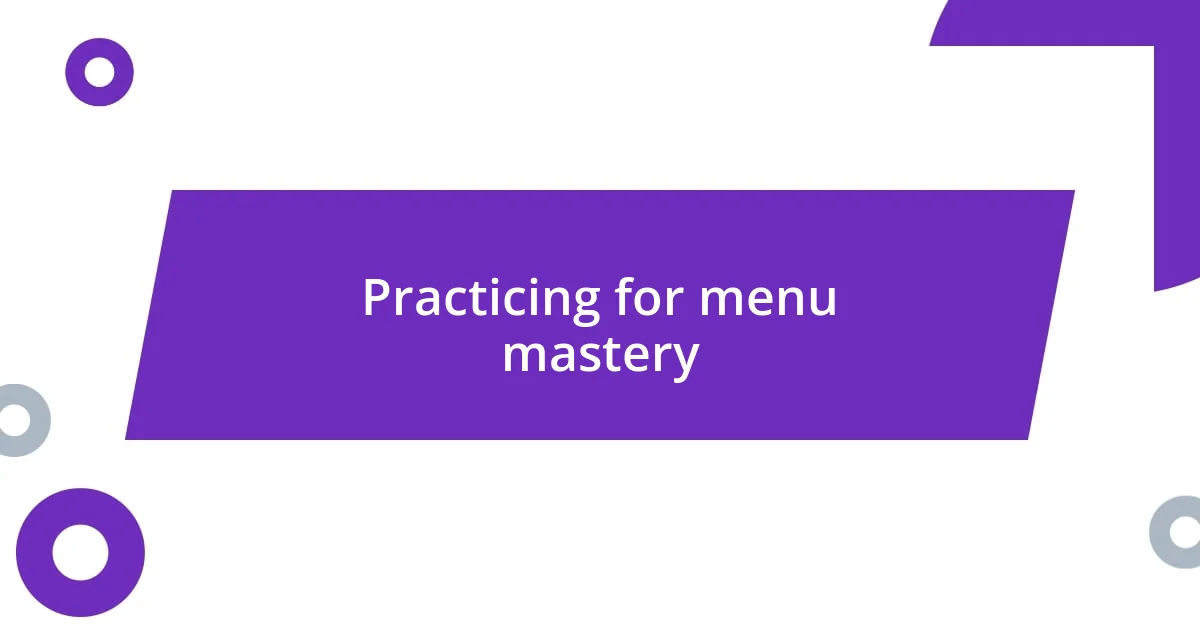Key takeaways:
- A well-structured menu enhances the dining experience by guiding choices, reflecting the restaurant’s identity, and showcasing signature dishes.
- Key features of an effective menu include engaging descriptions, dietary symbols for informed choices, and organized sections for easy navigation.
- Utilizing technology, such as restaurant apps and social media, can assist in menu exploration and help discover new dining experiences more effectively.

Understanding the menu layout
When I first approached the menu, I was struck by how the layout guided my choices. It’s interesting how a well-structured menu can tell a story, leading you from appetizers to desserts without a hitch. Have you ever noticed how certain categories feel like an invitation?
One restaurant I visited had its dishes organized by flavor profiles, which was a refreshing change from the usual method. I remember feeling an instant excitement while scanning through vibrant sections labeled “Spicy,” “Savory,” and “Sweet.” It made my decision-making process feel like an adventure, rather than a chore—does that resonate with you?
Ultimately, understanding the menu layout goes beyond just knowing where each section is. It’s about recognizing how these elements work together to enhance our dining experience. As I navigated through different menus, I realized that a well-crafted layout not only highlights a restaurant’s signature dishes but also reflects its identity. How much do you think the design of a menu influences your dining choices? I’ve found it makes a world of difference in setting the tone for the meal ahead.

Key features of the menu
One key feature that stands out in a menu is the use of descriptions. I once came across a menu that did an amazing job of painting a picture with words. Each dish was described in such mouthwatering detail that I could practically taste it before even ordering. Have you ever had a meal that sounded as good as it looked? I sure have, and it definitely enhances the whole experience.
Another important aspect is the inclusion of dietary symbols like vegetarian, gluten-free, or nut-free. This thoughtful addition makes it easier for diners like myself to make informed choices quickly, especially when dining out with friends who have specific dietary needs. I remember a dinner with friends where these symbols saved us time and cleared confusion, allowing more time for laughter and connection over delicious food.
Lastly, the organization of the menu is vital. A well-categorized menu allows for easy navigation, making it simple to find what you’re in the mood for. I once dined at a place where they grouped items by prep style—grilled, fried, or baked—which not only piqued my curiosity but also helped me narrow down my choices faster. Have you ever wished menus were presented like this? I believe it adds a unique twist to the dining experience.
| Feature | Description |
|---|---|
| Descriptive Language | Engaging and evocative descriptions enhance anticipation and decision-making. |
| Dietary Symbols | Indications like vegetarian or gluten-free simplify choices for diverse dietary needs. |
| Menu Organization | Categorizing by cooking style helps diners navigate their preferences quickly. |

Techniques for menu exploration
When exploring a menu, I’ve found that taking a moment to soak in the visuals can really set the stage for the experience. I’ve had nights where I just sat back, letting the colors and fonts speak to me. One time, I remember being so drawn to a menu with whimsical illustrations that it transformed my anticipation for the meal. It was like the artwork guided my taste buds towards uncharted flavors, sparking my curiosity.
Here are some techniques that have helped me navigate menus effortlessly:
- Scan for Highlights: I always look for emphasized dishes or chef specials—they often reveal the restaurant’s pride and best offerings.
- Use Sections as Clues: I tend to focus on thematic sections, which can naturally guide me to what I’m craving, like a rich pasta under “Comfort Classics.”
- Follow Your Senses: If a menu gives me a rich visual element, I trust that it might reflect equally delightful flavors.
- Ask for Suggestions: Engaging the staff has led me to discover hidden gems I might overlook otherwise. I recall a moment when I asked for a recommendation and was introduced to a dish I still dream about!
When I look at a menu, I take note of the atmosphere and even my own mood. I reflect on past dining experiences and how the energy of the surroundings influences my choices. A dimly lit spot with cozy seating often leads me to lean toward hearty comfort foods. Feeling adventurous? I might dive into an unfamiliar cuisine!

Tips for easy navigation
Navigating a menu can be a delightful experience if you know a few tricks. For me, it often starts with focusing on what catches my eye first—like a dish with an intriguing title. I remember one time, a unique dessert named “Chocolate Lava Surprise” had me captivated right away. Isn’t it interesting how a name can evoke curiosity and excitement? That little thrill of discovery can really shape your dining adventure.
Another tip I swear by is to take a moment to reflect on my cravings. I often ask myself what I’m in the mood for—something light and fresh, or rich and savory? On one occasion, I had been leaning towards a salad, but then a hearty lasagna caught my attention. It’s like I remembered the comfort of that cheesy goodness and realized I just had to indulge. Have you felt that internal pull between health and comfort food? It’s a common diner’s dilemma!
Lastly, I always recommend involving your dining companions in the decision. Engaging them in a conversation about their favorites can lead to a shared enthusiasm that enhances the experience. One time, while out with a group, a friend passionately described a seafood dish, which instantly made my decision clear. Isn’t it amazing how shared excitement and opinions can turn what might seem like a mere meal into a memorable and collaborative dining experience?

How to choose wisely
Choosing wisely from a menu is an art that requires a mix of intuition and strategy. I’ve learned to first consider my own cravings and look for dishes that resonate with my mood. For instance, one rainy evening, my heart was set on something indulgent, and I found myself drawn to a creamy risotto. That warm, velvety dish was exactly what I needed to lift my spirits—sometimes, simply trusting my instincts can lead to the best meals.
I find it helpful to pay attention to ingredients that speak to me personally. When scanning a menu, I often ask myself if there’s an ingredient I love, like truffle or fresh herbs. I remember one time, I spotted a dish containing rosemary, and I instantly knew I had to try it. The aromatic memory of rosemary from my grandmother’s kitchen flooded back, making the choice feel not just tasty but deeply personal. Isn’t it incredible how food can evoke such strong emotions and memories?
Lastly, I’ve discovered that being aware of seasonal specials can greatly influence my decision-making process. Restaurants often highlight dishes that showcase fresh, local ingredients, and I see these as opportunities for delightful surprises. On a recent visit to a farm-to-table eatery, the seasonal vegetable medley caught my eye, and I was rewarded with vibrant flavors that felt both nourishing and exciting. How often do we overlook the beauty of seasonal offerings when they can bring such joy to our plates?

Utilizing technology for assistance
Technology has become a powerful ally in menu navigation. I’ve often turned to restaurant apps or websites to peruse the menu before stepping foot into the establishment. Just the other week, I was in search of a new brunch spot, and using a popular dining app, I not only found the menu but read reviews that helped me gauge what dishes were crowd favorites. Isn’t it comforting to have such resources at your fingertips?
Additionally, I’ve found that social media platforms offer unique insights into a restaurant’s offerings. I remember scrolling through Instagram, where a vibrant photo of a colorful poke bowl caught my attention, leading me to a new eatery that I might have otherwise overlooked. It’s fascinating how platforms filled with visual content can make our meal choices feel more vibrant and exciting, don’t you think?
Finally, don’t underestimate the power of QR codes. Many restaurants now use them for digital menus, making it easy to browse at your leisure. On one occasion, I encountered a menu that had interactive elements—by scanning the code, I could not only view dishes but access chef recommendations and pairing suggestions. That seamless blend of technology and dining made the selection process enjoyable and engaging. How often do we get to experience a menu in such an innovative way?

Practicing for menu mastery
Practicing for menu mastery involves more than just familiarity—it’s about engaging in a process that enhances our confidence and enjoyment. One of my favorite practices is to recreate a menu at home, especially when I come across interesting dishes. I remember one weekend, I tried to mimic a wild mushroom risotto I had adored at a local Italian spot. I peeled back the layers of the recipe, slowly understanding each ingredients’ role, which gave me newfound appreciation each time I revisit that dish. Isn’t it fascinating how creating something can change your perception of it?
Another method I’ve adopted is to dive into the stories behind menu items. I once learned that a particular dish’s origin was rooted in a small Italian village, which added depth to my experience when I ordered it. Knowing the narrative behind a meal can transform it from a mere selection into a journey on a plate. For me, that sense of connection elevates the dining experience—have you ever felt that sense of belonging through the food you eat?
Lastly, I make it a point to practice with friends. We often turn our outings into a friendly competition—each of us chooses a dish for the table and presents our rationale. This not only diversifies our meal but also strengthens our menu navigation skills. A memorable night was when a friend picked a spice-laden lamb dish that none of us had considered, and it quickly became the star of the table. Experiencing different perspectives not only enhances our choices but creates bonds over shared deliciousness. How much fun is it to gather insights from others while savoring great food together?














